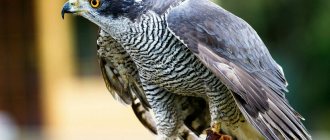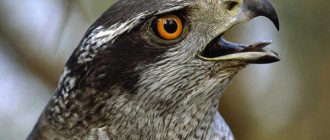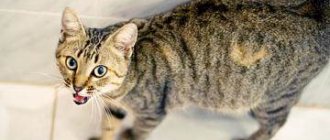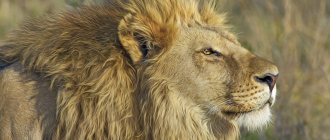Appearance
Impala antelopes have a lot in common with bulls; they have common features and similar hooves. Therefore, the antelope is classified as artiodactyl. This is a slender, beautiful animal of medium size. The animals' fur is smooth, shiny, and on the hind legs, right above the "heel" of the hoof, there is a tuft of coarse, black hairs. The animal has a small head, however, clear eyes, large, pointed, narrow ears.
One of the most important characteristics of all antelopes is their horns . Take a look and you will see for yourself that you can also tell from the horns that these animals are relatives of bulls. The horn of antelopes is a sharp bone rod that develops from the frontal bones on outgrowths. The bone rod is covered with a horny sheath, and this whole horny sheath, together with the rod, grows throughout its life , while the animal lives and exists. And also, antelopes do not shed their antlers every year, as happens with roe deer and deer. In males, the horns grow backward, upward or to the sides. Females do not have horns.
VIII generation (1999 - 2005)
The new Chevrolet Impala has become calmer in terms of design and no longer stands out from its competitors in anything special.
However, the developers focused on the convenience of the interior and its ergonomics. Work was also carried out on the chassis, which made it possible to optimize the behavior of the car when cornering and at high speed.
Specifications
The following power plants are available to choose from:
- 3.4 liter engine capable of producing 182 horsepower. Equipped with a four-speed automatic transmission.
- 3.8 liter engine. Its power is equal to 203, 243 horsepower. It works in conjunction with a four-speed automatic transmission.
Brief details:
| Engine displacement (liters) | Power characteristics (hp) | Gearbox type | Maximum speed threshold (km/h) |
| 3.4 | 182 | 4automatic | 215 |
| 3.8 | 203 | 4automatic | 200 |
| 3.8 | 243 | 4automatic | 220 |
Analyzing feedback from owners, engineers tried to adapt the Chevrolet Impala VIII to modern handling requirements without depriving it of comfort. Therefore, the car is designed on a new front-wheel drive platform. The suspension of both is independent, multi-link.
Friendly uniform
The Chevrolet Impala is hardly able to stand out from the crowd with its design. The sedan looks extremely ordinary and nothing in its appearance catches the eye. Of course, the round taillights integrated into the red monoblock create a hint of style, but the rounded body itself is not very expressive and lacks remarkable features.
Focus on functionality
The interior is also not particularly attractive. Moreover, the quality of the materials is frankly low - the plastic is hard and rattles on uneven surfaces. But the ergonomics of the driver’s seat turned out to be successful - all organs are within hand reach, while the steering wheel is equipped with control keys for the audio system and cruise control.
The driver's seat has pronounced lateral support, and the profile is quite comfortable for long journeys. The chair's adjustment range is wide, so it can easily accommodate a person of any size.
The rear sofa can accommodate three riders, but is molded only for two. There is enough room for knees even with a height of 190 centimeters.
Progress in the right direction
Despite the relatively moderate power of the 3.8-liter engine (243 horsepower), the Chevrolet Impala accelerates quite quickly.
The engine pulls confidently from the bottom, demonstrating pick-up at medium speeds, and the automatic transmission changes gears quickly. This allows you to easily stay in the general flow and be faster than it in some cases.
The sedan handles clearly and predictably. The steering wheel still lacks information content, but it is sensitive, while roll in corners is moderate. However, in order to optimize handling, it was necessary to sacrifice some driving comfort, which results in shaking on pronounced bumps.
Habitat
This species of antelope is widespread, ranging from Uganda to Kenya, all the way to Botswana and South Africa . This herbivore belongs to the bovid family and is found in savannas and woodlands. They prefer to settle mainly in open areas overgrown with sparse bushes. The animal's habitat extends to the southeastern regions of South Africa. Some impalas live between Namibia and Angola, in the border zone. This is a separate subspecies of antelope; these artiodactyls have a dark muzzle.
Females with small antelopes live in large groups; the number of such groups can be 10-100 individuals. Elderly and even young males sometimes form bachelor, unstable herds. The strongest males, who are not elderly, can have their own areas in order to vigilantly guard their territory from strangers and competitors. If it happens that a whole herd of females runs through the territory of one male, the male “takes” them to himself, takes care of each of them, believing that now each female is his.
ANTELOPE IMPALA
An impala that is running away from its pursuer can make magnificent jumps: having flown into the air, it seems to hover for a moment, pressing its legs under itself and throwing its head back. The jump can be up to 3 m in height, and even up to 10 m in length. It also raises the hair on the back of the body, thus notifying the rest of the herd of danger.
While fleeing, the impala's speed reaches 60 kilometers per hour. During the jump, she pushes off with her hind legs. One jump carries this animal 6 m forward and up to 3 m up. In case of immediate danger, the impala can overcome obstacles up to 2.5 m.
— Impala habitat
WHERE DOES HE LIVE?
Ippala lives in unspoiled areas of Eastern and Southern Africa. It also lives in many African national parks and reserves, where appropriate conditions are created for the existence of these animals.
PRESERVATION
In the past, these antelopes were hunted so intensively that they became extinct in many regions. However, recently these animals have settled in new areas.
Lifestyle
Impalas are typical herd animals that are occasionally found alone. Females with cubs gather in herds of up to 100 individuals. Males usually live in separate groups.
Since these antelopes are inhabitants of shrub savannah and dry woodlands, their herds inhabiting vast territories, depending on the time of year, move to higher or lower areas, to places where they find more food. Males are usually friendly towards each other. But as the rutting season approaches, one of them begins to lay claim to a site from which he must first drive other males away, and only then can he attract females. Most females choose the male in whose territory they find the best food.
During the dry season, impala antelopes form huge herds. Males leave their old areas, and even leaders lose territorial habits. When the dry season ends and living conditions improve, they begin to look for their own sites again. The fights that occur at this time between males do not lead to serious consequences.
Photo 11
Hollywood Boulevard, across from the Chinese Theater and the former Kodak Dolby Theater where the Oscars are held, is regularly closed for movie premieres or special events.
Both evenings that we were in the “city of angels”, events were taking place there, and traffic jams formed on the adjacent streets. There are traffic jams of people on the sidewalks. The most devoted fans of the actors took seats next to the red carpet from the night, almost a day before the start. Hollywood Boulevard, across from the Chinese Theater and the former Kodak Dolby Theater where the Oscars are held, is regularly closed for movie premieres or special events. Both evenings that we were in the “city of angels”, events were taking place there, and traffic jams formed on the adjacent streets. There are traffic jams of people on the sidewalks. The most devoted fans of the actors took seats next to the red carpet from the night, almost a day before the start. Hollywood Boulevard, across from the Chinese Theater and the former Kodak Dolby Theater where the Oscars are held, is regularly closed for movie premieres or special events. Both evenings that we were in the “city of angels”, events were taking place there, and traffic jams formed on the adjacent streets. There are traffic jams of people on the sidewalks. The most devoted fans of the actors took seats next to the red carpet from the night, almost a day before the start.
The next day our route was mostly along highways. This is where the Impala LTZ feels free: the suspension, improved compared to more “simple” trim levels, smoothly passes possible road irregularities, the car moves smoothly and practically does not react to air flows from oncoming cars. However, it is difficult to be close to them - almost everywhere the oncoming lanes of the highway are separated or even separated from each other by several meters. Speed on different types of highways varies from 55 to 75 mph, that is, from 85 to 120 km/h. Despite this, Americans drive over the speed limit, often quite seriously. Even the mountain serpentine, the so-called Big Sur, does not stop them: 90 km of highway with stunning views of the Pacific Ocean wind along the mountains. Where the speed limit is 35 mph, local drivers confidently keep it at least 45-50.
It should be noted here that the Impala’s heavy weight plays against itself. On a descent, in order to smoothly enter a turn or not miss it at all, you have to squeeze the brake pedal harder and do it in advance. The Impala's braking distance is much longer than other cars, which still takes some getting used to. Another detail is the small rearview mirrors. Moreover, the reflection in each of them is different: the left one brings objects closer closer than the right one.
Nutrition
- 35 facts about giraffes
- Animals of Crimea
- 36 facts about elephants
- Rodents
- 35 facts about foxes
- Animals of Brazil
Impala antelopes belong to the ruminant suborder, therefore, they feed on plant buds, shoots and leaves. They love to eat acacias . When the rainy season begins, animals love to nibble on the succulent grass. During the dry season, shrubs and shrubs serve as food for antelope. Such a changing, varied diet can only mean that animals receive good nutrition throughout the year, healthy food of relatively high quality, even in a small one area, and without the need to migrate.
These funny animals especially need constant drinking, so antelopes never settle where there is very little water. There are especially more of them near bodies of water.
WHAT DOES IT EAT?
Impalas feed primarily on grass; they also eat a lot of leaves, buds, shoots, fruits and seeds of plants. In most of their range, impalas prefer fresh, protein-rich grass, which is especially dense during the rainy season. When the grass withers during the dry season, antelope feed on the leaves of shrubs and perennials. These animals never move away from bodies of water.
During the dry season they must drink daily. Impalas, like other antelopes, often come to water during the hottest hours, because their main enemies (lions, leopards, hyenas and other predators) usually hunt at night and wait for their prey at the watering hole.
Reproduction
Mating among impala antelopes most often occurs in the spring months - March-May. However, in equatorial Africa, mating of antelopes can occur in any month. Before mating, the male antelope sniffs the female to check for estrogen in her urine. Only then does the male copulate with the female. Before copulation, the male begins to make his characteristic growls and roars, moving his head up and down, thus showing the female his intentions.
Female impala antelopes, after a gestation period of 194 - 200 days , and at the height of the rains, give birth to only one calf , whose weight is 1.5 - 2.4 kilograms. At this time, the female and her cub are most vulnerable, since most often they all fall into the field of view of predators. This is why many antelope cubs do not live to reach sexual maturity, which begins at the age of two. A young female impala antelope can give birth to her very first calf at 4 years of age. And males begin to take part in reproduction when they turn 5 years old.
Lowride
Subcultures of car lovers have their own brands associated with different trends. Designed to accelerate to maximum speeds, hot rods with large rear wheels are traditionally made from Ford vehicles. The basis for custom cars with large-scale modifications of the body and interior are, first of all, Mercury models. Well, lowriders are, of course, Chevrolet.
The first lowered cars appeared on the boulevards of Los Angeles and other American cities back in the 1930s. The country began to emerge from the Great Depression, and people began to think about something other than purchasing basic necessities. The cars were being lowered by young, specifically dressed Mexican fashionistas. They moved slowly through the streets so that those around them could get a good look at both the car and themselves.
The car was lowered in the simplest way - with the help of sandbags or other weights placed in the trunk. The consequences of such “tuning” have been preserved in the appearance of many modern lowriders, whose owners consider it correct to make the rear almost dragging on the ground, and leave the front raised up. However, there were also completely lowered cars, in which the front springs were shortened by several turns.
For fans of lowriders, the speed of the car and its technical characteristics as a whole are relegated to the background. The main thing here is appearance. That is why lowered cars, from the moment of their appearance, are always polished to a shine and hung with parts from more expensive models. Many accessories were added without any practical benefit - only to make the car look more expensive than the analogues from the same series driving nearby.
1 of 5
Lowride culture became popular after World War II. Released in 1958, the Impala became the most common basis for creating lowered cars for many years. We have already said that the model is now in its 10th generation. For the lowride culture, only its first 4 generations are interesting. Everything that happened after 1971 is a completely different, much more modest story. And before that, the Impala was simply gorgeous - no one thought about saving fuel, since the gasoline crisis had not yet broken out, provoked by the oil embargo of the OPEC countries protesting against the military assistance that the United States provided to Israel. In addition, the manufacturer has not yet begun to reduce the size of the Impala body. The model was offered in different versions: coupe, sedan, hardtop, station wagon and convertible.
At the end of the 1950s, lowride culture experienced another explosion caused by the emergence of several previously unavailable technological solutions. First, adjustable air suspension was invented as a response to stricter laws regarding lowered cars. Secondly, new ways of painting the body and original bright colors have appeared. Thirdly, the market was filled with third-party wheel rims, which replaced factory products.
A lowrider with hydraulic suspension based on the 1964 Chevrolet Impala on wire-rims became the most recognizable image of this automotive culture.
Enemies
The enemies of representatives of this species include leopards, lions, cheetahs, and hyenas. Impalas flee from them by running or hiding in cover. It is very difficult for a predator to catch up with a strong young animal. Therefore, it is mainly the cubs who die, as well as sick and old antelopes that do not have the strength to run quickly.
Artiodactyls escape from people in protected areas. About 50% of these animals live there. They are also kept in private farms. The population living in the west of the mainland is protected by Etosha National Park and farms located in Namibia. In general, this species is considered the most widespread of all antelope species in Africa.
Hive, Hbase, and Impala
Angled antelope or deer antelope
Though Cloudera Impala uses the same query language, metastore, and the user interface as Hive, it differs with Hive and HBase in certain aspects. The following table presents a comparative analysis among HBase, Hive, and Impala.
| HBase | Hive | Impala |
| HBase is a wide-column store database based on Apache Hadoop. It uses the concepts of BigTable. | Hive is a data warehouse software. Using this, we can access and manage large distributed datasets, built on Hadoop. | Impala is a tool to manage, analyze data that is stored on Hadoop. |
| The data model of HBase is wide column store. | Hive follows Relational model. | Impala follows Relational model. |
| HBase is developed using Java language. | Hive is developed using Java language. | Impala is developed using C++. |
| The data model of HBase is schema-free. | The data model of Hive is Schema-based. | The data model of Impala is Schema-based. |
| HBase provides Java, RESTful and, Thrift API's. | Hive provides JDBC, ODBC, Thrift API's. | Impala provides JDBC and ODBC API's. |
| Supports programming languages like C, C#, C++, Groovy, Java PHP, Python, and Scala. | Supports programming languages like C++, Java, PHP, and Python. | Impala supports all languages supporting JDBC/ODBC. |
| HBase provides support for triggers. | Hive does not provide any support for triggers. | Impala does not provide any support for triggers. |
All these three databases −
- Are NOSQL databases.
- Available as open source.
- Support server-side scripting.
- Follow ACID properties like Durability and Concurrency.
- Use sharding
for
partitioning
.
Interesting facts
- Living in a herd provides impalas with better protection from predators. In a large herd, the chances of noticing an enemy who is about to attack increase earlier. In the event of a sudden attack by predators, antelopes rush in all directions.
- Most impala cubs are born at midday, when their enemies are resting. Midday is the safest part of the day for these antelopes.
- Only males have horns. They use them during the rut, in fights for territory and females.
- The Impala jumps great. She can jump vertically up and to the side.
- Impalas are often preyed upon by lions, leopards and cheetahs. Like other antelope species, impalas must be constantly alert. These antelopes have good eyesight, hearing and sense of smell.
- Males secrete an oily liquid from their anal glands, the smell of which informs rivals about the position they occupy in the herd. Males of low rank secrete a small amount of this substance.
- The word "impala" comes from the Zulu language. From him came the name of the capital of Uganda - Kampala.
Video
How three lionesses plan a hunt for the fast Impala Antelope. Video (00:03:24)
When large prey, such as black buffalo, migrate, the lioness has to hunt small impalas, which are very fast and sensitive. The strategy of lionesses for hunting impalas is that the first lioness sneaks up as close as possible to the antelope and makes an attack, so she directs the prey to the right place in the right direction, the second lioness also corrects the trajectory of the impala, and the third makes a lightning-fast jump and the prey is caught . The lioness sprinter gets injured in such high jumps. In this video, the attacking lioness dies three days later due to injuries during the fall.
How do they reproduce?
The breeding season for antelopes is tied to the season. Usually babies are born after the rains, when the pastures are covered with dense young vegetation.
Small varieties of antelope are polygamous; males of large varieties collect harems of several females during mating. The duration of pregnancy is from 5.5 to 9 months.
Before giving birth, the female sets up a shelter in dense thickets, under stone sheds or in another secluded place. Antelopes usually give birth to one baby at a time. After birth, the baby immediately stands on its feet and begins to suck mother's milk. In some varieties, the cubs begin to follow the female on the very first day, in others, in the first days they hide in thickets of grass or bushes.
After 2-3 months, the babies begin to graze, and after another six months they become completely independent. Young antelopes living in numerous herds remain in the parental group. Species that form small groups usually expel young that become independent.
IV generation (1964 - 1970)
The Chevrolet Impala was first presented to the public in 1963 as a pre-production model. The serial version of the model was released in 1964. The car had a monumental body design, in addition, it received a respectable interior design and high capacity.
The Chevrolet Impala was available in several body styles:
- Hardtop sedan.
- Hardtop coupe.
- Cabriolet.
- Five-door station wagon.
At the moment, the car belongs to the category of retro cars. Its price in Russia starts at 3.5 million rubles.
Specifications
There were many power plants under the hood. Here are the main ones:
- Installation 3.8 liters. The nominal power output is 142 horsepower.
- Engine 4.1 liter. Produces 157 horsepower.
- Engine 4.6 liters. The power potential is 223 “horses”.
- Power unit with a volume of 5.4 liters, developing 279 forces.
- Engine 6.7 liters. Power is 405 horsepower.
- Unit 7.0 liters. The power potential is 431 “horses”.
All engines were equipped with three-speed manual or automatic transmissions.
Data in brief:
| Displacement of the power unit (in liters) | Power characteristics (hp) | Gearbox type | Speed limit (km/h) |
| 3.8 | 142 | 3MKP/3AKP | 145 |
| 4.1 | 157 | 3MKP/3AKP | 145 |
| 4.6 | 223 | 3MKP/3AKP | 170 |
| 5.4 | 279 | 3MKP/3AKP | 184 |
| 6.7 | 405 | 3MKP/3AKP | 190 |
| 7.0 | 431 | 3MKP/3AKP | 190 |
It is worth mentioning the Chevrolet Impala in the SS modification (427), which was released in 1967. Under the hood, this two-door coupe hid a 6.7-liter engine with a power of 425 horsepower, which allowed it to accelerate to a maximum of 200 kilometers per hour.
On the outside, the Impala SS was distinguished by appropriate nameplates, while inside a new steering wheel was installed, the instrument panel was upholstered differently, and three-point seat belts were installed.
Strictness is at the forefront
The Chevrolet Impala has an attractive appearance, but at the same time the body design itself is extremely laconic. Strict lines can only be diversified by convex rear fenders and a faceted radiator grille, while dual headlight optics and an abundance of chrome were considered quite commonplace at that time.
Luxury and comfort
The interior decoration pleases with the respectable design of the dashboard. It houses an instrument panel with large wells and clear font, a climate system, and a radio receiver. The central tunnel is decorated with aluminum trim, and the steering wheel has a sporty three-spoke design.
The driver's seat will accommodate even a very large driver, but it does not have side support or a profile. The second-row sofa is extremely spacious and four passengers can fit on it - this is a very real fact.
Storm of the streets
The seven-liter power unit, which produces 431 horsepower, has excess traction at low and medium speeds, which provokes severe slipping when the accelerator is sharply pressed to the floor.
At the same time, the acceleration itself occurs smoothly and unobtrusively. The automatic transmission works relatively quickly and changes gears smoothly.
The steering is nothing special. The steering wheel is very heavy and uninformative, which makes maneuvers at high speed difficult. Moreover, there is significant roll and oversteer when cornering.
The suspension gently overcomes bumps of any caliber. But strong rocking on the waves of the road surface can provoke an attack of seasickness in riders.
Using Impala Shell (impala-shell command)
You can use the Impala shell tool (impala-shell) to configure databases and tables, insert data, and issue queries. For ad hoc queries and research, you can send SQL queries in an interactive session. To automate your work, you can specify command line parameters to process a single statement or script file. The Impala Shell interpreter accepts all of the same SQL statements specified in Impala SQL reporting, as well as some shell-only commands that you can use to tune performance and diagnose problems.
The impala-shell command fits into the familiar Unix toolchain:
- This option allows you to issue a single request from the command line without launching an interactive interpreter. You can use this option to run impala-shell from a shell script or using command calling syntax from Python, Perl, or another script.
- The option allows you to process a file that contains multiple SQL statements, such as a set of reports or DDL statements to create a group of tables and views.
- The parameter allows substitution variables to be passed to statements executed by this impala-shell session, such as statements in a script file processed by the parameter. You encode a substitution variable on the command line using the notation. In an SQL expression, you substitute a value using the notation . This feature is available in Impala 2.5 and higher.
- This option allows you to save the query output to a file.
- The option turns off pretty-printing so that you can produce comma-delimited, tab-delimited, or other delimited text files as output. (Use the option to select the separator character, the default is the tab character).
- In non-interactive mode, query output is printed to stdout or to the file specified by the , while random output is printed to stderr, so you can only process query output as part of the Unix pipeline.
- Impala-shell's interactive mode uses a facility to recall and edit previous commands.
Characteristics and description
Antelopes are social animals. They form herds, the number of which can range from several animals to several hundred individuals. The severity of the hierarchy in the herd also varies greatly. In most species, the dominant position is occupied by the male, while in small groups he may be the only sexually mature male.
Many antelopes are characterized by seasonal migrations in search of more fertile pastures. They prefer to feed during daylight hours, since during the day it is easier to notice danger. When predators appear, animals flee and, in extreme cases, use their horns for defense.
Horns
No other species of artiodactyl has such a variety of shapes, colors and lengths of horns as antelopes. Thus, in saber-horned antelopes (addax, oryx, oryx), they are very long, arched and curved back. In the steppe hartebeest, the horns grow from one base and bend outward and upward in the shape of a crescent. The four-horned (or Indian) antelope has two pairs of horns, with the front pair being small and almost invisible, and the back pair reaching 10 cm.
The length of the outgrowths can vary from a few centimeters to a meter.
What does it look like
Despite the many different varieties, the appearance of antelopes has several common characteristics:
- the body is elongated, rounded in section;
- the legs are long, strong, but thin, making even large animals seem more graceful;
- the neck is quite long, the head is medium-sized with an elongated muzzle and large ears directed to the sides, which is why gazelles look protruding.
The color is dominated by various variations of brown. Most species have a darker upper body and a lighter belly. Many antelopes are characterized by masks on their faces, stripes and spots.
How many years do they live
The lifespan of antelopes directly depends on their size. The largest animals can live up to 16-20 years, while the age of pygmy antelopes rarely exceeds 8-10 years.











